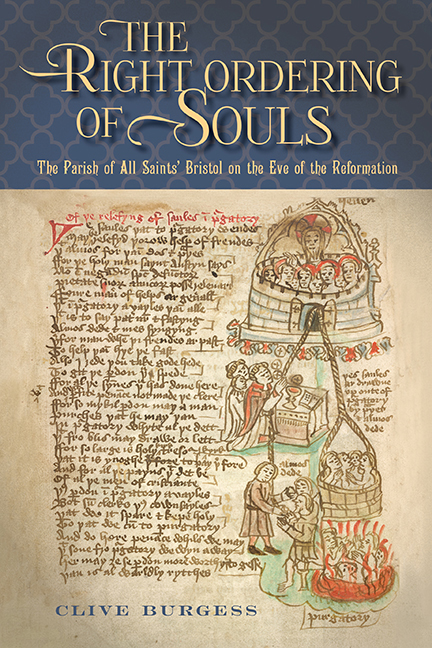Book contents
- Frontmatter
- Dedication
- Contents
- List of illustrations
- Acknowledgements
- Miscellaneous Frontmatter
- Abbreviations
- Notes
- map
- Part I For the increase of the divine service
- Part II All Saints’, Bristol, and its parishioners
- Part III Commemorating the dead
- 6 ‘In possession for the profit of the church’: Securing commemoration in the parish
- 7 ‘For all future time’: The Halleways’ Chantry
- Coda
- Part IV Leaders and administrators
- Part V Ordering the parish
- Appendices
- Bibliography
- Glossary
- Index
- Miscellaneous Endmatter
Coda
from Part III - Commemorating the dead
Published online by Cambridge University Press: 05 May 2018
- Frontmatter
- Dedication
- Contents
- List of illustrations
- Acknowledgements
- Miscellaneous Frontmatter
- Abbreviations
- Notes
- map
- Part I For the increase of the divine service
- Part II All Saints’, Bristol, and its parishioners
- Part III Commemorating the dead
- 6 ‘In possession for the profit of the church’: Securing commemoration in the parish
- 7 ‘For all future time’: The Halleways’ Chantry
- Coda
- Part IV Leaders and administrators
- Part V Ordering the parish
- Appendices
- Bibliography
- Glossary
- Index
- Miscellaneous Endmatter
Summary
THE chapters in this section have, respectively, outlined commemorative practice within All Saints’ and explored the archive that survives for the Halleways’ chantry. Some of the themes arising should now be considered, to make some observations concerning practice both within All Saints’ and also Bristol itself.
‘And what good they did in their days’: Implications of commemoration in All Saints’
By 1470, the endowment income that the churchwardens of All Saints’ relied upon had long been steady at some £8 per annum. This derived from property, much the most lucrative of which was the Green Lattice devised by Alice Halye in the late thirteenth century and, to a lesser degree, from rents of assize, of which William Newbery's, standing at 12s. per annum, was the most generous. But the prognosis for parish finances would not have been encouraging. Rents of assize had become increasingly unreliable and, even if they had all been operational, at some 25s. per annum their yield was hardly princely. Moreover, while the parish had long maintained the Green Lattice, it had become dilapidated by the early 1440s, explaining why Richard Haddon underwrote extensive repairs in order to restore it. Such a commission, however, was redolent of a spirit of enterprise which, in the decades preceding the mid-century, began to transform the parish.
POLICY-MAKING BY THE ELITE
The first signs of this spirit found expression in the campaign to rebuild the south, or Cross, aisle, coming to fruition in the 1430s; this was financed in part by funds raised from parishioners, but was apparently primed by gifts from the wealthy, the Halleways prominent among them. Following shortly after, in the 1440s, Richard Haddon rebuilt the north, or Lady, aisle. The families leading these initiatives were themselves closely connected, for not only did Richard Haddon have links with Thomas and Joan Halleway and their associates, with both Thomas and Richard having served with John Gyllard as executors in the disposition of Christine Haddon's estate, but Richard Haddon and Richard Hatter also served as bailiffs of Bristol in 1443.
- Type
- Chapter
- Information
- 'The Right Ordering of Souls'The Parish of All Saints’ Bristol on the Eve of the Reformation, pp. 252 - 258Publisher: Boydell & BrewerPrint publication year: 2018

